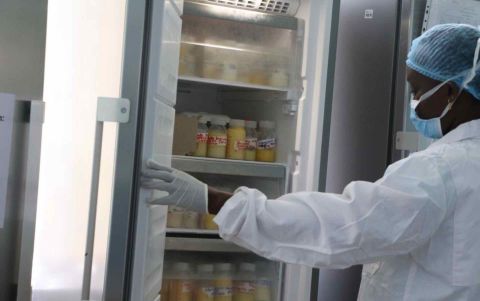
By Richard Ariong, Jordan Chamberlin (CIMMYT), Sarah Wairimu Kariuki and Bjorn Van Campenhout (IFPRI)
The dairy sub-sector in Uganda has witnessed a remarkable transformation over the last few decades. Just ten years ago, dairy exports were negligible; today, the sub-sector comes in third after coffee and fish as the country’s top agricultural export earner. This transformation is especially apparent in the southwest of the country, where a steady supply of raw milk, a broad network of milk collection centers, and the arrival of a handful of large processors provided a promising context for dairy value chain upgrading.
One of the key supply-side drivers of this transformation is technology adoption by smallholder farmers. While 10 years ago, more than half of the animals in the herd of a typical farmer were of the indigenous type, these days the typical herd consists of almost 90 percent of improved animals, mostly crossbreeds of over 75 percent Holstein-Friesian progeny. The improved cows not only produce significantly more milk than local Ankole breeds, they also have longer lactation periods, leading to a substantial increase in smallholder dairy farmer productivity and cash income, with attendant poverty reduction and improved nutritional outcomes.
Unfortunately, exotic cattle are also much more susceptible to ticks than local breeds. As a result, the use of acaricides – topical veterinary medicines that are used to kill ticks – has increased. Unfortunately, suboptimal acaricide usage and related management practices have led to acaricide resistance by ticks, with the result that these treatments are increasingly ineffective for tick control. At present, tick-borne diseases such as East Coast Fever and anaplasmosis are very widespread and constitute an important threat to the industry, leading some farmers to switch back to local breeds or to exit the sector altogether.
Evidence suggests that farmers are becoming increasingly desperate in their strategies to fight ticks. In recent fieldwork, we heard numerous stories of farmers using non-veterinary pesticides and insecticides (sometimes in combination with acaricides) to control tick infestations. While this approach sometimes works to kill ticks, it also can cause serious health issues – often fatal – for the cows being treated. These off-label “concoctions” are not only harmful for the animals, but also for the farmers applying them, and may translate into a public health hazard if they end up in milk.
To get a clear picture of the prevalence of this practice, we implemented a list experiment. List experiments are typically used to measure something that is deemed sensitive by survey respondents. Direct questions on sensitive issues may result in untruthful (under)reporting, due to stigma, shame, social desirability or social pressures, and/or fear of censure or legal action. List experiments have been used to measure the prevalence of intimate partner violence, female genital cutting, and condom use, among others.
List experiments are an indirect survey method. In a typical implementation, half of a survey sample is randomly subjected to a “direct response” group and the other half to a “veiled response” group. In the direct response group, a list of non-sensitive items is presented, and the respondent is asked to indicate how many of the listed practices apply. In the veiled response group, the sensitive item is added to the list of non-sensitive items, and the respondent is again asked to indicate how many of the practices are used. When the sample is large enough, one can get an estimate of the prevalence of the sensitive item by subtracting the average number of items reported by the direct response group from the average number of items reported by the veiled response group (see this resource for more detailed examples). It is important to note that respondents are not asked to indicate which specific practices they use, only the total number of practices, which masks their admission of using any specific practice (including the sensitive practice which they may be reluctant to report directly).
In our list experiment, the direct response group consisted of seven practices commonly used to fight ticks by farmers in the area. These included various ways of spraying (hand pump, motorized pump, spray race, etc.), the use of a cattle dip, and vaccination. The veiled response group listed the same seven practices plus the practice of using unsanctioned mixes of non-veterinary chemicals like pesticides and insecticides. As we were dealing with a population that were potentially illiterate, we also created two cards (one for the direct response group and one for the veiled response group) that visualized the different tick control methods/practices.
We find that 16 percent of farmers, or almost 2 in every 10 farmers, have used mixtures of non-veterinary toxic chemicals to fight ticks in the preceding year. While this may seem like a relatively small share of farmers, it should be noted that milk is generally aggregated in milk collection centers, such that potential public health effects may be much larger – as well as more difficult to trace and control. In addition to the public health issues, there may be significant value chain implications. For example, export channels may be closed to milk supply areas that are known to have contamination issues. Currently, there are few processors that test for traces of pesticides in raw milk. Furthermore, while the Dairy Development Authority has facilities in Kampala to check for chemical residues, current institutional infrastructure limits the scalability of such testing in the field. We hope that through the generation of new data on the magnitude of the problem, and analysis of its potential consequences, stakeholders throughout the value chain are nudged into action.



